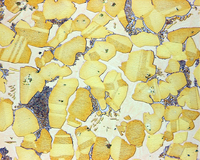
Photo from wikipedia
In this paper, the influence mechanism of tempering temperature on the microstructure and mechanical properties of 35CrMo steel used in the hammerhead of piston-type impact pile hammer is systematically analyzed.… Click to show full abstract
In this paper, the influence mechanism of tempering temperature on the microstructure and mechanical properties of 35CrMo steel used in the hammerhead of piston-type impact pile hammer is systematically analyzed. The microstructure was characterized by scanning and transmission electron microscope, X-ray diffraction, and electron backscattering diffraction, and the mechanical properties were tested by the uniaxial tensile test and Charpy V-notch impact test. The results show that after tempering at 580–680 °C, the microstructure of 35CrMo is tempered sorbite. With the increase in tempering temperature, the α phase in the matrix gradually recovers, the dislocation density decreases, the low-angle grain boundaries gradually change to the high-angle grain boundaries, and the carbides gradually change from long rod-shaped network continuous distribution to spherical uniform dispersion distribution, but all of them are M3C. Meanwhile, with the increase in tempering temperature, the strength decreases and the toughness increases, which is mainly affected by dislocation density and matrix supersaturation. Furthermore, 35CrMo enters the two-phase zone after tempering at 710–740 °C, and its microstructure is lamellar martensite, with carbide dissolved. At this point, its mechanical properties mainly depend on grain size.
Journal Title: Metals
Year Published: 2023
Link to full text (if available)
Share on Social Media: Sign Up to like & get
recommendations!